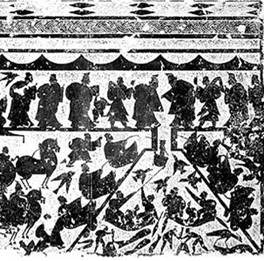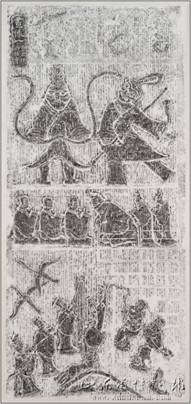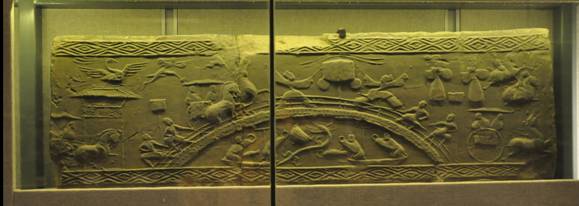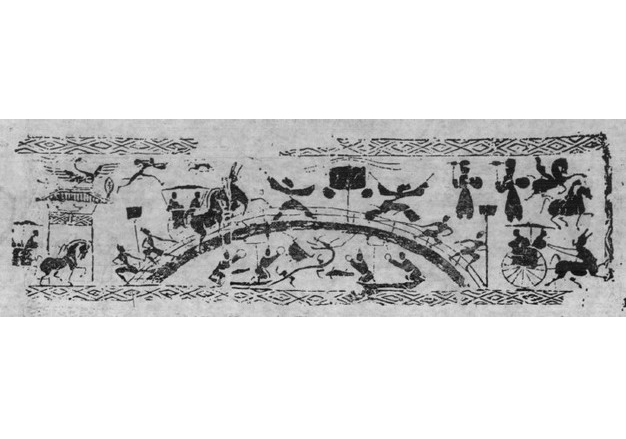Pictorial bricks were mainly used for building tomb chambers, and were mostly found in present-day Henan, Sichuan, Jiangsu, Shaanxi, Shanxi, so on. Han dynasty witnessed the heyday in the progress of the funeral pictorial bricks, when they spread to the areas of Nanyang, Xinye[2]. Though not an expensive material, pictorial bricks are rich in illustrations, with well-designed compositions. The tombs build of the pictorial bricks are mostly small ones, therefore, we believe that the tomb occupants of such tombs are largely middle and lower class officials.
The story “Fishing the caldron from the Sishui River” can be found in the relevant historical texts. The Annals of Qin Shihuang in the Records of the Grand Historian stated: in the course of touring for inspection, Qin Shihuang” came to Pengcheng, fasted and prayed for fishing the Zhou Caldron from Sishui River. He ordered as many as thousands of laborers to salvage it but failed.” Being told that the Zhou Caldron of Zhou court, the sign of the sovereign power had been dumped into the Sishui River at the place, Qin Shihuang ordered a large number of people to dive into the river to salvage it, but resulted in vain. The volume Sishui in Shui Jing Zhu (literally Commentary on the Waterways of the Classic) by Li Daoyuan, recorded in details the reason and process of salvaging the Zhou Caldron from Sishui River for Qin Shihuang: In the 29th year of the rein of King Xian of Zhou dynasty, the Jiuding (Nine Caldrons) were sunk into the Sishui River. After Qin Shihuang came to power, the Jiuding appeared from the river. Believed that his virtues and merits could be matched with that of the previous dynasties, i.e. Xia, Shang, Zhou; Qin Shihuang got in an ecstasy of delight, and made one thousand people into the river to search for them, but failed, because the Dings (caldrons) has hidden up, that is called “Ding hiding”. And it was said the caldrons had ever been tied to the rope and pulled, but failed to get them out, for the rope was cut off by the teeth of the dragon.
Ding (caldron) was used for cooking and ceremonies in ancient times, and also the insignia for power. Xia court divided their territory into nine states, thus nine Dings(caldrons), stood for the nine states, and were inscribed with the prestigious mountains and rivers of each state. During the Zhou dynasty, Ding had come to signifying the sovereign power, and it was supposed to be attained exclusively by the virtuous monarchs. The subsequent idioms “Wen ding zhong yuan”(Struggle for conquering the Central Plains where the capital located) , “San zu ding li”(confrontation among three forces) turned into the synonym for power struggle.
In the late Spring and Autumn Period, the warlords vied for supremacy with constant battles. It was presumed that the Jiudings(Nine Caldrons) survived three dynasties, resulted in the Sishui River for the turbulent period. After ascended the throne followed the unification of China, Qin Shihuang launched a tour in the country, and at the place named Pengcheng, he saw the Nine Caldrons emerged from the water and got very excited. He thought his noble virtues were in accordance with the standards of the previous three dynasties, and sent thousands of people to get into water for searching, unfortunately found nothing. However, some said the Nine Caldrons had got into hiding, while others said the rope tied to the caldrons was bitten off by the dragon in the course of pulling.
The story of “Salvaging the caldrons from Sishui river” were largely found on the pictorial bricks, masonry tombs, and other stone building materials of the Han dynasty. The statistics indicates that as many as 30 Han portraits with the abovementioned theme were discovered in Shandong, Jiangsu, Henan, and Sichuan province[3].
Another pictorial brick with the identical story excavated from Nanyang, Henan province(fig.2) shares similar pictorial layout with the piece focused on in this essay which was discovered from Xinye county, Nanyang city, but with some variation. For instance, the Sishui bridge was located in the right side of the image, Jian drum and the drummers at the left side of the bridge rather than on the bridge; the chariot, and the horses in particular, were on the top of the bridge; the number of the draggers for the caldron increased to six; similarly, there were two boats in the river with only one person in the each of them; additionally, no dragon can be seen in the river. Despite this, this image is apparently about the same story of the “Salvaging the caldron from Sishui River”, and the posture of the figures are much like that of the pictorial brick from Xinye county.

Fig.2 The pattern of “Salvaging caldron from Sishui River” on the pictorial brick from Nanyang city[4]
Except for the bricks, many pictorial stones also bear the same-themed images, e.g. the pictorial stone (fig.3) with the pattern of “Salvaging caldron from Sishui River” discovered from Wuliang ancestral temple in Jiaxiang county, Jining city, Shangdong province [5]. In this image, fish and waterfowls were intentionally designed to stand for the surface of the river.

Fig.3 the pattern of "Salvaging caldron from the Sishui River" from Wuliang ancestral temple
in Jiaxiang county, Shandong province[6]
Built in the late Eastern Han dynasty, Wuliang ancestral temple, in which the image of Salvaging caldron from Sishui River was found, attested to the prevalence of the historical legend at the time.
The pattern of Salvaging caldron from the Sishui River on the pictorial stone(fig.4) was excavated from Hongfu temple in Jiaxiang county, Shandong province[7]. The composition of this work can be divided into three sections; the upper part is decorated with snake dance, the middle part are figures, and the lower part is about the Salvaging caldron from the Sishui River. Compare with that of pictorial bricks from Xinye, Nanyang city, Henan province, and Wuliang ancestral temple of Shandong province, the layout of the image is much simplified with a undersized bridge, but the stressed impressions of the draggers can be seen.

Fig.4 The pattern of Salvaging caldron from the Sishui River on the pictorial stone excavated
from Hongfu temple in Jiaxiang county, Shandong province[8]
The same-themed pattern was found on the pictorial stone of the early Eastern Han dynasty (Fig.5)excavated from Sunjiacun village, Wenshang county, Jining county, Shandong province[9].

Fig.5 The pattern of Salvaging caldron from the Sishui River on the pictorial stone
excavated from Wenshang county, Shandong province[10]
The comparison of the aforementioned multiple images of “Salvaging Caldron from the Sishui River” on the pictorial bricks from various sites indicates explicitly that the images on the pictorial bricks are by and large more expressive than that on the pictorial stones, the figures and the scenes were depicted more naturally, vividly, which were determined by the producing methods and the degree of the difficulty between the two categories. Though being different in the simplicity of the image, the ways of salvaging caldron, the highlighted parts of the pattern are Sishui bridge and the flock of people salvaging caldron, and the identical implication expressed which reflects the ideology of Interactions Between Heaven and Mankind of Han people, the folk religious belief and the views on life and death in Han dynasty[11].
Have the Jiudings (Nine Caldrons) ever been really existed? What historical enlightenment can we get from the legend of “salvaging caldron from the Sishui River”?
Your answer please, if you have any questions or answer, please feel free to send us email, we are waiting for your answers and participation, and your comments, answers and suggestions will be highly appreciated. We will select and publicize the most appropriate answers and comments some time in the future.
Weekly Selection Email: meizhouyipin@chnmus.net
Reference:
[1]Han Pictorial Brick Tomb at Fanji, Xinye, Journal of Archaeology 1990(4), Cultural Relics Institute of Nanyang Prefecture.
[2]Volume Qin-Han in Journal of Chinese Archaeology, Chinese Social Science Press, 2010. Institute of Archaeology, Chinese Academy of Social Sciences.
[3][11] Yang Xiaojun, Hao Lirong, The social significance and symbolism of life & death of “Fishing Caldron” in the Han images, Southeast Culture journal, 2011(2).
[4]Zhou Dao, Lv Pin, Tang Wenxing, Pictorial Bricks of Han Dynasty In Henan Province. Shanghai Fine Arts Press, 1985
[5][6]Wu Hong, Liangwu Ancestral Temple: The Ideology in the Pictorial Art of Ancient China, Sanlian Bookstore.2010
[7][8]Website of Shandong Museum: http://www.sdmuseum.com/gcbd_show.aspx?id=2387&cid=41.
[9][10]Fu Xihua, Complete Set of Pictorial Bricks of Han Dynasty, Volume 2. One of the Serial Pictorial Books by Beijing Sinology Institute in Paris University: pic. 87,88
The rubbing, from this Pictorial Brick which was made by molding and pressing, and found in the No.24 Han tomb at Fanji township in Xinye county, Nanyang city, Henan province (fig.1), features an arched Sishui bridge in the center, with a drum on the right of the center flanked by two drummers. On the left of the bridge is a horse-drawn chariot with two persons. On the ends of the bridge, two persons are painstakingly dragging a rope with their bodies leaning backward, the gap in the lower part of the rope indicates that the rope has parted. Under the bridge, a dragon leaped out of the water, on the left of the dragon’s head is a tilted caldron, under which links the other end of the parted rope, signifying that the rope was cut off by the teeth of the dragon, and the dragon is flanked by two boats, each has two persons striking the musical instruments for cheering on, seemingly for scaring off the leaping dragon. Additionally, on the either ends of the brick, i.e. the roads to the bridge, there are chariots, pedestrians, tower, whose doors are decorated with Zhuque, a mythical bird, and feathered human, etc, the place looks like a high street. The scene on the pictorial brick depicts the historical legend “ Fishing the Caldron from Sishui River for Qi Shihuangdi”.

Fig.1 Pictorial Brick with illustrations of Salvaging Caldron from Sishui River
Artistically, the illustration covered the whole brick without margin. The producer created a sense of three dimensional lower reliefs by means of pressing craftsmanship. With concise lines, the portrayal underlined the representation of the dynamic parts with the people beating the drum, figures struggling to drag the rope, neighing galloping horses, the leaping dragon’s head, and tilted caldron, thus effectively intensified the atmosphere, presenting a lifelike, intense and spectacular scene of “salvaging the caldron from Sishui River”, make the viewers feel being on the scene.
In terms of the social philosophy manifested by the portrayal on the pictorial brick, it describes the historical story about Shihuangdi of Qin Dynasty who failed to amass the nine caldrons, the symbol of imperial power, implying the doomed powerful Qin court, about to be replaced by its successor, showing the acceptance by Han people to the collapse of the Qin dynasty and the support to the subsequent Han dynasty which acquired the mandate of heaven.

Postgraduate in the School of Archaeology and Museology, Beijing University

Title: Pictorial Brick with Legend of Salvaging Caldron from Sishui River
Medium: clay
Period: late Western Han Dynasty
Measurement: H.34cm, W.112cm
Provenance: excavated from No.24 Han tomb at Fanji township in Xinye county, Nanyang city, Henan province in 1985.